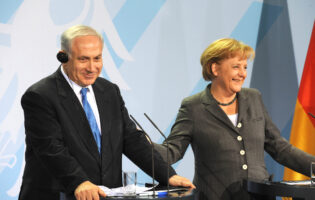Territorial Tensions in North East Asia – Lessons from German Reconciliation
On February 28, 2013, the AGI Harry & Helen Gray Program hosted a seminar entitled “Territorial Tensions in North East Asia: Lessons from German Reconciliation.” The main topic of discussion was the difficulty of solving the territorial dispute between South Korea, Japan, and China over the Senkaku/Diaoyu and Dokdo/Takeshima islands.
In Dr. Daqing Yang’s historical approach, the territorial dispute between Japan and China can be divided into five phases. In the first phase, the islands were initially Chinese, but were annexed by Japan in 1895 during the First Sino-Japanese War with little resistance (this marks the second phase). After Japan’s defeat in WWII, Japanese territory became controlled by the United States (the third phase). During this phase oil deposits were discovered by a UN-sponsored surveying team in 1969 before the region was returned to Japan in 1972. In the fourth phase the formal dispute began in 1970 when China claimed that this region was rightfully theirs. But even with China’s claims to the Senkaku/Diaoyu islands, the dispute did not escalate until the 1990s and 2000’s, marking the fifth phase. Tensions grew when the Japanese government denied the existence of a tacit agreement to discuss the islands. China’s stance is that the islands were annexed illegally and that according to the Cairo Accords the islands should have been returned. There are also different global, regional, bilateral, power balance, and domestic factors that are shaping the way this dispute evolves. There was little to no contention prior to the discovery of oil in the region.
Dr. Somei Kobayashi offered what he called an idealistic approach to the territorial dispute between countries in the North East Asian region. South Korea and Japan have had a “friendly” relationship which has recently been on a decline. One example was the visit of a South Korean president to the Takeshima island region. This event caused uproar amongst Japanese officials, which led Japanese Prime Minister Abe to demand an apology from the South Korean government. Japanese officials are relying on international law and historical events to try and mitigate this dispute. He, in addition, proposed two ideas. First, the Japanese need to work towards historical reconciliation with East Asian countries in the process of solving the Senkaku issue. Second, he offered Okinawa’s participation for solving it by providing the Prefectural Government with extensive authorities. Dr. Kobayashi pointed out that historical reconciliation and Okinawa’s participation could become the great significant keys to overcome the conflicts and then to establish the peace in East Asia.
Dr. J.J. Suh offered further insight on the Japanese-Korean dispute; he stated that the Japanese claim to the Dokdo island region is illegitimate. The island territory was gained through illegal occupation during the latter half of the 19th century, and therefore Japan has no claim to them. There are striking differences between the disputes that Japan has with China and South Korea, and this is mainly defined by the different methods in which the countries have carried out relations with each other. To elaborate on his point, Dr. Suh described several different categories of relations:
- When both countries have similar management frameworks and high levels of acknowledgement of legitimacy in the dispute, it would allow for meaningful dialogue to occur between countries, or regions
- Similar management frameworks, but with little acknowledgement of legitimation between countries, would allow for tacit understanding, but little dialogue would actually occur.
- If countries have different management frameworks but they have high acknowledgment of each other, this can be categorized by contention, which prolongs tension and does not create meaningful dialogue.
- If countries do not share any framework and they do not acknowledge each other’s legitimacy in the dispute (characterized by nationalist spheres), there will be poor relations between countries.
Categorizing these disputes might provide an indicator on how successful dialogue might be, but what is even more important is determining why management has failed. The complexity of the situation in the Pacific is overall due to the economic situation. Due to the interdependencies within the region, if trade is cut or hindered, the economic ramifications could hurt major production facilities housed in the region. This economic backlash could also extend well beyond the Pacific region.
Dr. Lily Gardner Feldman concluded the presentation by offering her insights on the German model of reconciliation, especially the territorial disputes that were the result of WWII. There are eight lessons that should be taken away from these disputes:
- Reconciliation and territorial disputes take time to be resolved, so it is important to continue to foster relations between the countries involved.
- There needs to be recognition of the grievances, even if there is no resolution.
- Regional forces play a role in territorial disputes.
- Societal forces serve as a catalyst for change in these regions, which is important to the entire process.
- Moral and pragmatic motivation must exist to resolve these disputes.
- Political leaders play a key role in the success of disputes. This is a double edged sword because these leaders can either hurt or help the process.
- Books, such as history text books, should be created by all parties involved; the adoption of these books carries the same significance as the collaboration of the parties involved.
- The last point, and perhaps the most significant, is that the U.S. played an active role in the disputes after WWII. The U.S. has yet to really get involved with the disputes between China and Japan, and South Korea and Japan.
Keeping all of that in mind, the German model might offer some semblance of a solution to the disputes occurring in the Asian Pacific region. By examining examples such as the return of the Sudetenland in former Czechoslovakia, the recognition of the Oder-Neisse border in Poland, and the territorial redistribution of the Saarland show that an important component to the reconciliation process can be resolving territorial disputes. In the case of the Asian Pacific, significant work must be done, but if the German model can offer one lesson, it should be that relations should not suffer while the lengthy reconciliation process is ongoing.







